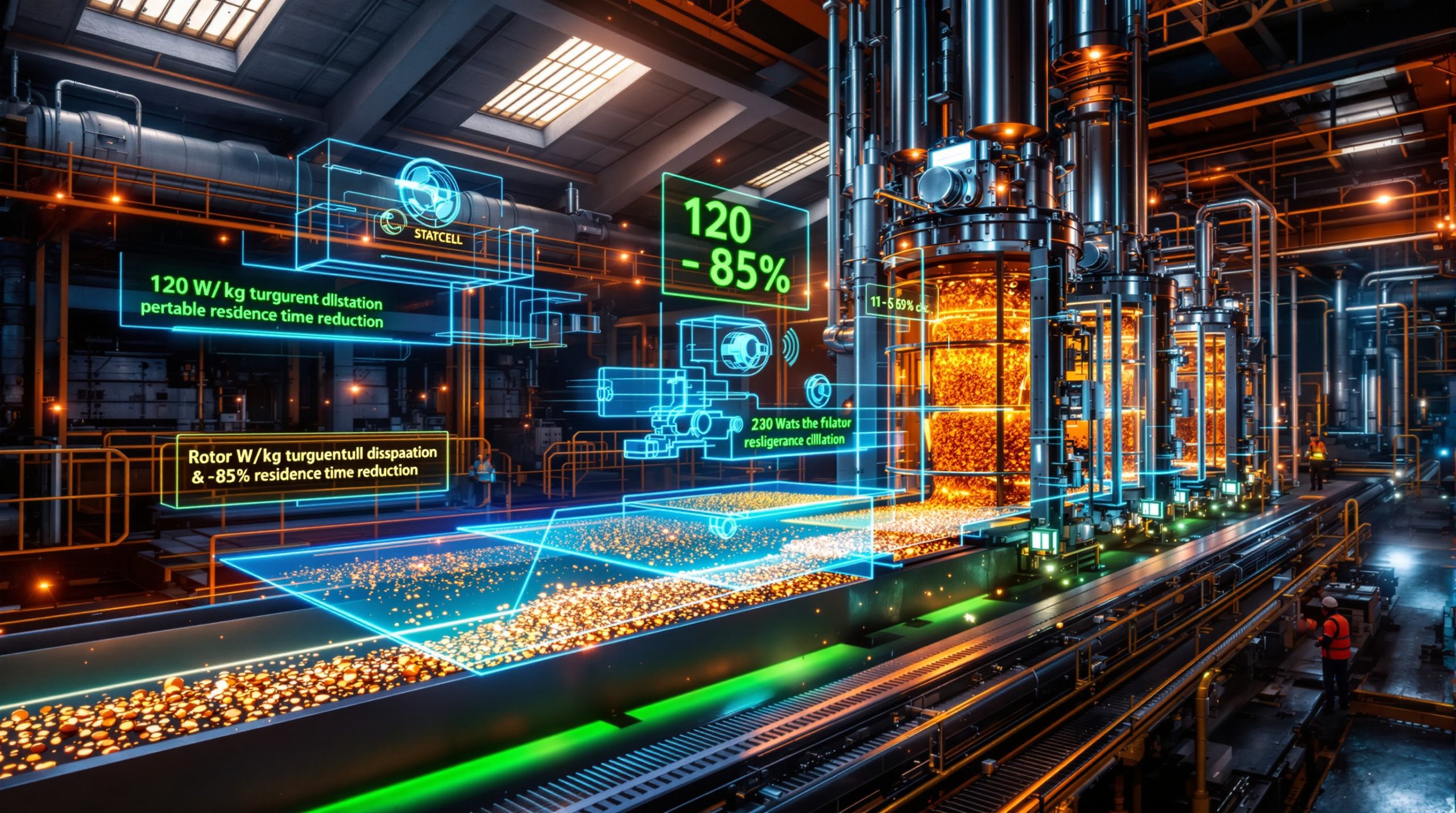The Engineering Revolution Behind Fine Particle Recovery in Modern Mineral Processing
Contemporary mineral processing faces unprecedented challenges as global metal demand intensifies while ore quality systematically deteriorates. Traditional flotation methodologies, developed for higher-grade deposits, struggle to maintain efficiency when confronting the ultrafine particle recovery requirements of today's complex ore bodies. This technical reality has driven the development of advanced separation technologies that fundamentally reimagine how particle-collection mechanics operate, with StackCell flotation technology representing a significant breakthrough in this evolution.
The emergence of compact, high-intensity flotation systems represents more than incremental improvement; it signifies a paradigm shift toward energy-efficient processing architectures capable of handling the geometric material volume increases required to maintain production levels. As copper ore grades decline from historical ranges of 0.8-1.0 kg/tonne to contemporary averages approaching 0.5 kg/tonne, mining operations must process nearly double the material volume using comparable energy and infrastructure resources.
Revolutionary Mechanical Design Philosophy in Advanced Flotation Systems
Fundamental Engineering Principles of Two-Stage Separation
Advanced StackCell flotation technology employs a mechanically distinct approach by separating two conventionally integrated functions within mineral processing circuits. The first stage focuses exclusively on high-intensity particle collection through turbulent energy dissipation, while the second stage optimises phase separation and froth recovery within a stable environment. This architectural separation eliminates the engineering compromises inherent in conventional flotation cells, where turbulence requirements for bubble-particle attachment conflict with stability demands essential for clean separation.
The collection chamber achieves turbulent dissipation rates reaching 120 W/kg through specialised rotor-stator configurations, substantially exceeding conventional mechanical cell capabilities operating at 24-30 W/kg ranges. This concentrated energy application enables superior collision mechanics specifically targeting particles within the 5-25 micrometer size spectrum, where traditional systems demonstrate reduced capture efficiency.
Quantified Performance Advantages Over Conventional Flotation
Performance Comparison: StackCell vs Conventional Flotation Systems
| Metric | StackCell Technology | Conventional Systems | Improvement Factor |
|---|---|---|---|
| Turbulent Dissipation Rate | 120 W/kg | 24-30 W/kg | 4-5x higher |
| Energy Consumption | 33% of conventional | Baseline | 66% reduction |
| Installation Footprint | 50% reduction | Baseline | 2x more compact |
| Foundation Load Requirements | 30% of conventional | Baseline | 70% reduction |
| Flotation Residence Time | 15-25% of conventional | Baseline | 75-85% reduction |
These performance metrics translate into measurable operational advantages across multiple dimensions. The 66% energy consumption reduction directly supports mining companies' decarbonisation commitments while reducing operational costs. Furthermore, the 50% footprint reduction enables brownfield expansions within existing plant boundaries, addressing space constraints that typically require expensive facility relocations or major infrastructure modifications. These improvements align with broader mining industry evolution trends towards more efficient processing methods.
Multi-Stage Rotor Configuration and Energy Distribution
The multi-stage rotor-stator design enables independent optimisation of each processing zone through precise energy distribution control. Unlike conventional flotation cells that must balance competing requirements within a single chamber, this configuration concentrates turbulent energy exactly where bubble-particle collision mechanics demand maximum dissipation rates. The resulting particle attachment probability increases substantially for ultrafine materials that conventional systems permit to escape directly into tailings streams.
High-Intensity Turbulence Applications in Ultrafine Particle Capture
Scientific Principles of Enhanced Collision Mechanics
High-intensity turbulence fundamentally alters the collision frequency and attachment probability dynamics within flotation systems. At 120 W/kg dissipation rates, the turbulent energy distribution creates substantially more frequent bubble-particle encounters compared to conventional systems. This increased collision frequency directly correlates with improved attachment probability, particularly critical for particles approaching 5-25 micrometer dimensions where conventional flotation cells demonstrate insufficient capture efficiency.
The mathematical relationship between turbulent dissipation and particle recovery becomes increasingly important as ore complexity increases. Particles reaching 20 micrometers or smaller dimensions experience inadequate turbulent energy in traditional cells, causing them to report directly to tailings without mineral recovery. The enhanced turbulence capability specifically targets these ultrafine particles that represent lost revenue in conventional operations.
Addressing Systematic Ore Grade Decline Challenges
"With copper ore grades dropping from historical levels of 0.8-1.0 kg/tonne to approximately 0.5 kg/tonne, mining operations face the mathematical impossibility of maintaining production levels without processing nearly double the material volume using equivalent energy and infrastructure resources."
This geometric requirement creates operational constraints that conventional flotation frameworks cannot address effectively. Sites requiring 15-20% throughput increases typically lack the real estate, power capacity, or water access necessary for traditional expansion approaches. Consequently, the combination of declining ore grades and increasing environmental compliance requirements demands processing solutions that can achieve superior metallurgical performance within constrained operational parameters.
Commodity-Specific Implementation Applications
Primary Application Sectors:
• Precious Metals Recovery: Enhanced gold and silver recovery from complex sulphide ores requiring ultrafine liberation
• Base Metals Processing: Copper, lead, and zinc operations targeting improved recovery from declining ore grades
• Critical Minerals Extraction: Rare earth elements and lithium processing requiring selective fine particle separation
• Coal Beneficiation: Fine coal recovery and ash rejection in challenging geological formations
Each commodity sector presents distinct challenges requiring specialised approach modifications. Coal operations in Queensland have deployed over 15 StackCell units, demonstrating established market adoption within the coal beneficiation sector. Western Australian copper, gold, and rare earth processing facilities utilise the technology for fine particle recovery improvements across multiple ore types and processing methodologies.
Economic Benefits and Environmental Impact of Compact Processing Design
Capital Cost Reduction Through Infrastructure Optimisation
Primary Economic Advantages:
- Structural Engineering Savings: 70% reduction in foundation and structural load requirements
- Brownfield Expansion Capability: Retrofits within existing plant footprints without facility expansion
- Maintenance Simplification: Reduced mechanical complexity through design architecture optimisation
- Reagent Consumption Efficiency: Improved particle selectivity reducing chemical usage and waste generation
The 70% foundation load reduction provides particular value for high-altitude operations approaching 4,000 meters elevation and remote sites where construction infrastructure presents logistical challenges and substantial costs. Sites constrained by limited access roads or challenging terrain experience significantly reduced installation complexity and associated expenses.
Sustainability Performance and Environmental Stewardship
Advanced StackCell flotation technology contributes to mining industry sustainability objectives through multiple integrated benefits. Lower energy consumption directly reduces operational carbon footprint whilst supporting corporate net-zero target frameworks. Reduced reagent consumption through improved selectivity decreases chemical usage and associated tailings contamination concerns. In addition, the smaller physical footprint minimises site environmental impact and supports modern planning & ESG compliance requirements.
Environmental Impact Quantification:
• Carbon Footprint Reduction: 66% energy consumption decrease translates to substantial CO₂ equivalent emissions reduction
• Water Usage Optimisation: Compact design reduces water circulation requirements in arid mining regions
• Chemical Consumption: Enhanced selectivity reduces collector and frother reagent dosing requirements
• Land Use Efficiency: 50% footprint reduction minimises surface disturbance and infrastructure requirements
Economic Modelling for Different Operational Scales
Return on investment calculations vary significantly based on operational scale, commodity type, and geographic constraints. Operations processing 1,000-5,000 tonnes per day typically achieve payback periods of 18-36 months through combined energy savings, increased recovery, and reduced maintenance costs. However, larger operations exceeding 10,000 tonnes per day can achieve payback periods under 24 months due to economies of scale in energy consumption reduction and production optimisation benefits.
Integration Strategies for Existing Flotation Circuits
Retrofit Implementation Methodologies
StackCell technology's modular architecture enables straightforward integration into existing flotation circuits without requiring comprehensive circuit redesign. The compact design permits installation within existing plant footprints, addressing capital constraints and operational continuity requirements that typically preclude complete circuit replacement approaches.
Three Primary Integration Scenarios:
- Scavenger Circuit Enhancement: Downstream installation captures particles escaping conventional rougher cells
- Cleaner-Scavenger Configuration: Combined high-intensity cleaning with fine particle recovery from cleaner tailings
- Tailings Recovery Implementation: Secondary processing of historical flotation tailings for ultrafine mineral capture
Global Deployment Distribution and Market Validation
Confirmed Installation Distribution:
| Region | Application Sector | Installation Quantity | Operational Environment |
|---|---|---|---|
| Queensland, Australia | Coal Operations | 15+ units | Established market adoption |
| Western Australia | Copper/Gold/Rare Earths | Multiple sites | Diverse ore types |
| South America | High-Altitude Mines | Specialised applications | 4,000m+ elevations |
| North America | Cold-Climate Operations | Indoor installations | Sub-zero temperature control |
The geographic distribution reflects market-driven demand correlating with specific operational challenges. Queensland coal operations benefit from compact design advantages within established processing circuits. Furthermore, Western Australian installations demonstrate technology versatility across copper, gold, and rare earth processing methodologies. High-altitude South American deployments address infrastructure constraints where conventional expansion approaches prove economically prohibitive.
Case Study: Mt Keith Nickel Concentrator Implementation
The Mt Keith Nickel Concentrator serves as a performance benchmarking site for metallurgical validation and recovery rate improvements targeting slow-floating minerals. This BHP-operated facility in Western Australia provides major mining company validation of advanced flotation technology across challenging nickel sulphide ore processing requirements.
Implementation Benefits:
• Recovery Rate Improvements: Quantified increases in fine particle capture efficiency
• Metallurgical Performance: Enhanced grade-recovery optimisation across complex ore variations
• Operational Integration: Successful retrofit within existing circuit configuration
• Energy Efficiency: Demonstrated energy consumption reduction supporting sustainability objectives
Technical Specifications and System Capabilities
Core Engineering Parameters and Performance Characteristics
Technical Performance Specifications:
• Flotation Rate Constant: 4-5x higher than conventional flotation cells
• Particle Size Optimisation Range: 5-25 μm primary focus with capability extending to ultrafine dimensions
• Turbulent Dissipation Rate Capability: Maximum 120 W/kg concentrated in collection chamber
• Residence Time Requirements: 75-85% reduction potential compared to conventional systems
• Energy Consumption Profile: Approximately one-third of comparable conventional flotation systems
These specifications enable processing operations to achieve superior metallurgical performance whilst reducing energy consumption and infrastructure requirements. The 4-5x higher flotation rate constant particularly benefits operations processing complex ores requiring extended residence times in conventional systems. Additionally, these capabilities support data-driven operations by providing quantifiable performance improvements.
Complementary Technology Integration with HydroFloat Systems
Advanced flotation circuits benefit from integrated technology approaches addressing complete particle size spectrums. HydroFloat coarse particle flotation systems handle larger material fractions whilst StackCell technology captures ultrafine particles, creating synergistic processing configurations that maximise overall circuit performance.
Integrated System Benefits:
• Complete Size Spectrum Coverage: Coarse particle recovery through HydroFloat with ultrafine capture via StackCell
• Circuit Optimisation: Combined systems enable comprehensive particle recovery across all size ranges
• Metallurgical Performance: Enhanced grade-recovery relationships through optimised particle size management
• Operational Efficiency: Reduced overall energy consumption through specialised system deployment
Future Applications and Mining Industry Evolution
Responding to Resource Depletion and Complexity Increases
Future mining operations will confront increasingly complex ore bodies requiring sophisticated processing approaches. Fine particle recovery assumes greater importance as primary mineral deposits become depleted and operations transition to lower-grade, more geometrically complex resources. For instance, advanced flotation technology provides the processing capability necessary to maintain economic viability across these challenging geological conditions.
Remote operation considerations become increasingly important as accessible deposits become exhausted. Operations in challenging environments benefit from compact, energy-efficient systems requiring minimal maintenance and infrastructure support. Consequently, the combination of reduced footprint, lower energy consumption, and simplified mechanical design addresses multiple constraints simultaneously, supporting both mineral beneficiation opportunities and operational sustainability.
Innovation Pipeline and Technology Development Priorities
Continued technology development focuses on expanding particle size range capabilities, improving energy efficiency further, and enhancing selectivity across diverse ore types. Research and development investments prioritise customer collaboration to address emerging challenges within specific commodity sectors and geographic regions, including integration with renewable energy mining initiatives.
Development Focus Areas:
• Particle Size Range Extension: Expanding effective recovery range to capture increasingly fine particle distributions
• Energy Efficiency Optimisation: Further reducing energy consumption whilst maintaining metallurgical performance
• Selectivity Enhancement: Improving grade-recovery relationships across complex mineral associations
• Automation Integration: Developing advanced process control systems for autonomous operation capabilities
Implementation Assessment Criteria for Mining Engineers
Site-Specific Evaluation Parameters
Frequently Asked Questions:
What ore characteristics make advanced flotation most beneficial?
Operations processing fine-grained ores, complex mineralogy, or seeking to recover ultrafine particles from tailings streams achieve maximum benefit. Declining ore grades requiring increased throughput without facility expansion also represent ideal applications.
How does elevation affect flotation system performance?
High-altitude installations benefit significantly from compact design and reduced infrastructure requirements. Operations approaching 4,000 meters elevation face substantial logistical constraints where traditional expansion approaches prove economically prohibitive.
What maintenance considerations apply to advanced systems?
Simplified mechanical design reduces maintenance complexity compared to conventional flotation cells. The decoupled architecture enables independent maintenance of collection and separation zones, minimising operational disruptions.
Return on Investment and Economic Modelling
ROI calculations must incorporate multiple benefit streams including energy cost reduction, increased metal recovery, reduced maintenance expenses, and avoided capital expenditure for conventional expansion. Payback periods typically range from 18-36 months depending on operational scale, commodity prices, and site-specific constraints.
Economic Assessment Factors:
• Energy Cost Savings: 66% reduction in flotation energy consumption
• Recovery Improvements: Quantified increases in fine particle capture rates
• Maintenance Cost Reduction: Simplified mechanical design reducing maintenance requirements
• Capital Avoidance: Eliminating need for conventional circuit expansion
Transforming Mineral Recovery Through Advanced Engineering
Industry Impact and Technology Adoption Trends
Advanced flotation technology adoption continues expanding across global mining operations as ore complexity increases and environmental requirements intensify. The combination of superior metallurgical performance, reduced energy consumption, and compact design addresses multiple industry challenges simultaneously.
Technology deployment demonstrates particular strength in copper and gold projects worldwide, where increasing demand meets increasingly complex ore bodies. The projected strong copper demand over the next decade, combined with continuing ore grade decline, creates sustained market demand for processing technologies capable of efficient high-volume operation.
Contribution to Sustainable Mining Practices
Advanced flotation systems contribute meaningfully to mining industry sustainability objectives through energy efficiency, reduced environmental footprint, and improved resource recovery. The technology enables operations to achieve superior environmental performance whilst maintaining economic viability across challenging geological conditions.
The integration of compact, energy-efficient processing solutions represents a fundamental shift toward sustainable mineral recovery methodologies. By enabling superior metallurgical performance within reduced infrastructure requirements, StackCell flotation technology demonstrates that environmental stewardship and operational efficiency can achieve mutually reinforcing objectives within contemporary mining operations.
This analysis examines advanced flotation technology applications within modern mining operations. Readers interested in detailed technical specifications or implementation guidance should consult qualified process engineering professionals and conduct site-specific feasibility assessments appropriate to their operational requirements.
Ready to Capitalise on the Next Mineral Processing Innovation?
Discovery Alert's proprietary Discovery IQ model delivers real-time notifications on significant ASX mineral discoveries, transforming complex geological data into actionable investment insights for companies pioneering advanced processing technologies like StackCell flotation systems. Begin your 30-day free trial today and position yourself ahead of the market as the mining industry embraces revolutionary processing methodologies that enhance both profitability and sustainability.




